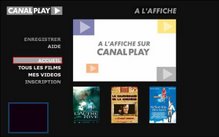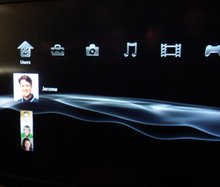Solutions: Dominance in the delivery of video and advertising to a living room TV audience is such a great price, that many are reluctant to collaborate for fear of reducing their share of such a prize. As well as an uncooperative business environment, there are software-complexities and hardware-cost obstacles that prevent the emergence of open-platform solutions.
Behind the scene: The PC, with its browser support, has set a standard for open PC-web development. Using networked PC-assistance, the existing and open software infrastructure can continue to support open access to TV-web. Via technologies such as active-TV, a TV can be free to openly browse TV-websites, including those with supporting the latest Web 2.0 features. This is achieved while adding minimal cost to the TV and without burdening it with maintenance or feature-longevity complexities. Moreover, this approach produces a much more interesting experience for users than more expensive and un-assisted TVs, which have less Web 2.0 support and are tied to business deals involving limited video portal access.
An industry problem ?
No doubt you have been following recent announcements from Samsung, Panasonic, Sharp,and likely others, that they will add access to internet video on new networked TVs – sometime in the first half of 2008. Many reporters are now saying 2008 will be the year in which Internet-delivered video reaches a large living room TV audience.
The technical approach by and large involves integrating support software to enable the TV to access a video supplier’s portal or tailored RSS feeds. This portal styled approach, however, does not enable the TV to access any video feed or even easily keep pace with the rapid changes in web technology. Maybe these TV suppliers are hoping customers will just buy another TV when they all too quickly discover that the features supported by their TV's integrated software are increasingly inferior to next month’s model...
The problem of building a STB or TV capable of dealing with all Internet video sources and variants was recently discussed by Amino’s marketing VP (the number one supplier in IPTV boxes): “... Simply offering our boxes in retail wouldn't work: there's just not enough consistency and standardization out there to make doing that a proposition that would be satisfying to consumers”. Note that the lack of standardization is not a problem for the PC, which has the support software to deal with it; it is a problem for a low-cost, low-maintenance and longer-life TV.
Jeremy Allaire and Adam Berrey of Brightcove, have published an open letter to the CE industry requesting a joint effort to bring standards to internet TV appliances. The letter states: “An even greater limitation than complexity is the fact that today's strategies are fundamentally closed”. They go on to say:
Each device has a different set of standards and requirements for using online video content, so there is no consistency of formats and user experience.
Most devices don't provide open access to any video service that is hosted on the open Web, and instead require direct deals and relationships with the device vendor.
Related to the above, none of these devices offer a simple and open development model for web service developers to create and deliver custom content and services.
Unlike the PC-based web and the mobile-web, which are both built on open standards, the consumer electronics ecosystem offers no consistent set of open standards for online media to reach televisions. [end quote]
The letter proposes some very good solutions, such as standardizing on an XML format for video RSS feeds. But without a dominant TV hardware platform leading the way via an all-pervasive application software standard, there is no coordinated effort to date to build a TV software infrastructure conforming to a single standard.
Consequently, likely accompanying each of the new networked TVs or networked Set-Top Boxes (STB) is a Software Development Kit (SDK), which application developers would have to use to build video portal interfaces or screen widgets. Given the endless possibilities for variants, this is likely to add 'SDK fatigue' to the growing DMA fatigue.
CE developers don’t feel equipped to take on an effort to drive some kind of Web 2.0 technology standard for the TV. The task is difficult, to be sure. Comparable projects from Microsoft, Intel Viiv and AMD Live!, have all met with failure. There are also large differences in the capabilities of TV Systems-on-a-Chip (SoC) used in the CE industry. It would certainly be possible to build a standard around something like Apple TV, given that it is basically a headless PC without the problems of the Windows operating system. However, a $15 TV SoC cannot replicate the software support of an Apple TV. If this were possible, the market would be awash with $15 integrated-PC browser systems. I could suggest that the home PC user would greatly appreciate such a device, but the PC industry is not yet capable not interested in supplying such a solution.
Maybe the networked TV buyer must factor in a low-end, PC-like cost adder to their TV purchase or be content with the meager video offerings and low-end features available in first-generation networked TVs? Buyer’s enthusiasm for adding, say, $250 to a TV appears weak. Hence, the recent Apple TV price reduction from $299 to $230. Sharp has suggested it will charge $200 more for its networked TV models, which have limited portal support. Maybe Apple will offer Apple TV integrated into a TV, once it clears unsold Apple TVs. This may motivate an industry response, but it is not the establishment of a standard...
The Brigtcove letter states that “closed” is a greater limitation than “complexity”. I think “complexity” refers to system configuration and maintenance rather than cost. I am not sure I agree with this part of an otherwise excellent letter. The PC-in the living room was an open solution, but more significant to its downfall than 'too-much-noise' or 'too-much-cost', was 'too-much-maintenance support'!
Web 2.0 technology for PC-web continues to develop rapidly, with new 'must-have' features continually emerging. We should expect web 2.0 support for the TV to show a similar development pattern. It is hard enough, maybe impossible. for the CE industry to standardize on a reduced set of Web 2.0 features, all supported by a $15 TV SoC today; it would be even more difficult to keep pace with PC-web 2.0 developments, without the added hassle of TV maintenance and compatibility problems.
I think an unalterable requirement for TV buyers is reliability and 'zero TV maintenance'. New TV buyers might be prepared to reconfigure their file sever or home network router, once; but they are not willing to maintain TV plug-ins and drivers. It would remind them too much of their Windows PC. They may have accepted the maintenance cost of PC-web access, but they don’t want to double this burden by adding similar PC-like TV maintenance.
I submit that active-TV technology frees a TV from dealing with the lack of simple Internet-video and Web 2.0 standards. Via PC-assistance, a networked TV presents web pages formatted for the TV. These TV-web pages (or channels) are easy to build and can come from a great many sources. The system is flexible, easily upgradeable, maintains TV reliability, is universally accessible and keeps the TV-side costs down. By maintaining a PC’s access to TV-web, a networked TV user can utilize this cost-effective resource to support browsing of TV-web.
A networked TV connects to the internet via a home router or gateway. A home PC also connects to the internet via the same router. Active-TV technology requires a PC be left in standby mode, in case it receives a request from the TV, via the home router, for temporary assistance in processing Web 2.0 software. The energy costs of keeping the PC in standby mode are less than the energy costs of a large plasma or LCD TV. Anyway, the PC may be simultaneously and invisibly used by another person who is also accessing TV-web or PC-web pages or channels.
Internet Video Broadcaster support
DivX officially launched its active-TV technology-styled “DivX-Connected" DMA at CES 2008, having first seen demand for this product in Europe. With the goal of continuing to expanding support beyond Stage6, DivX announced that they will add video from the popular Internet Broadcaster Veoh. Not surprisingly, there is already an active-TV technology supported TV-web channel for Veoh (see below).
Clearly, Veoh is showing enthusiasm for reaching the living room TV on platforms other than the living room PC. However, if TV manufacturers continue along a 'please-use-my-SDK path', then a video broadcaster’s ability to reach a living room audience will be constrained. This may result in a shake-out of internet video broadcasters.

As internet video providers are under pressure to make money from PC-web or TV access, the greater freedom of PC-web access may not be easily translated to TV access. For example, YouTube may allow free access to its PC-website, but it may become more restrictive in granting a standalone-TV access to its video. YouTube and other Internet broadcasters may prefer a TV portal to an open TV-website. This would enable them to better control deals with TV builders and advertisers, and monetize their video on TV. If this is the case, the industry would not be driven in the 'open' direction proposed in the Brightcove letter; instead, the establishment of open TV-web browsing -- similar to PC-web browsing -- using technology such as active-TV, would be delayed.
It is easy to build a TV-website or channel using familiar PC-web browser technology: HTML, Javascript and Flash. Below is an example: a TV image of a TV-web channel for videos available through Internet video broadcaster, ROO. The video menu shows three options: “World News”, “Travel Europe” and “Entertainment News”. These are selected from the ROO “setting”s page, which offers about 170 menu choices. The video, like Veoh video, is of a much higher visual quality than YouTube video.

The advocates of a standalone TV approach, that is a TV operating without any PC assistance, do not expect the TV to replace all PC-web functions. They don’t expect triple-tap entry via the TV remote to be used to search for and organize all video. Everyone agrees that this is still a job for the PC. This is similar to managing an Apple iPod from its iTunes PC or Mac interface.
Networked TVs will also have to solve the problem of filtering video for ‘family’ viewing. Many parents will not allow their kids to use a networked TV to freely search and access video from YouTube. It is easier to define video search criteria, manage video playlists, and control video filtering from the PC than a simpler networked TV. This better enables the user to enjoy the relevant video at the TV without continual interruption and excessive TV interactivity.
I think portal restrictions, lack of open internet-video access, and failure to keep up with the latest Web 2.0 technology experienced on the PC, will prevent first generation stand-alone networked TVs from widespread adoption.
TV access to shared photos
Several of the networked TV announcements indicated they would have support for internet photo sharing. One such popular site is Google’s Picasa. A prototype TV-web channel for Picasa has already been built. There is a menu button which enables photos to be viewed full-screen in a slideshow sequence. The familiarity and productivity of TV-web or TV-web development tools greatly simplify this kind of development. It will be hard to for an array of TV SDK users to keep pace with TV-web development.

For those less familiar with Picasa, the PC-website below is used to upload photos for sharing with other web users.

Using the menu-settings page of the Picasa TV-web channel (see below), a photo album can be selected. A user must first enter a Picasa User ID (this is stored for future use). Photos can be viewed individually, or as a slide show. This is a great way for a PC user to “send” photos for someone else to view on their internet connected TV.

Torrenting from the TV
Another industry leader, the BBC’s Ashley Highfield, has also been blogging about the lack of industry standards. Like Brightcove he is hoping for “a simple, elegant, cheap, open standards box, that easily allows streamed or downloaded, free, rented, or bought programmes”. Importantly, the “cheap” requirement has not been overlooked.
Maybe the networked TV user does not need the Web 2.0 features of PC-web. If this is the case, then when the business conflicts are finally resolved, the industry can provide a cheap solution. Maybe TV users will step-up to paying the additional cost of Apple TV-like hardware. However, there has been strong evidence indicating that they are not yet ready for this expense. If Web 2.0 is required at the TV, then the problems of unwanted hardware cost, too much TV maintenance and networked-TV feature-longevity, are all resolved by using a PC-assisted approach.

The Highfield blog goes on to say, “mentioning this to a very tech savvy colleague this morning, he replied that he downloaded programmes through BBC iPlayer [on a PC], stripped the DRM (hence his anonymity!), re-encoded the file, burned it to DVD from his PC, then took it to his DVD player connected to his TV in the lounge. Hardly a solution for my mum either.”
It is quite easy for active-TV technology to greatly simply the practical steps being taken by Ashley’s “tech savvy colleague”. No doubt there are a great many PC-web users who torrent (peer-to-peer transfer) video to their home PC. This video is typically provided in MPEG4 variants such as DivX. If the user does not own a MPEG-4 enabled DVD player, they mostly transcode the video to MPEG-2 format for playing on a ‘normal’ DVD player. The whole process of going to the PC to initiate a torrent (P2P), transcoding the video, writing a disc and 'sneaker-netting' it to the living room DVD player can be replaced by a simple TV-web site which supports torrents.
I have built support for the popular uTorrent engine into a demonstration TV-web channel. Now using only the IR remote of an active-TV enabled TV or STB, such as the D-Link DSM520, I can control all the necessary steps from the TV, without ever visiting the PC.
For demonstration, I added support for video torrents offered by http://www.democracynow.org/ and http://www.bittorrent.com/. The torrents are provided by RSS feeds. BitTorrent has feeds for “TV” or “Movies”. This explains the “TV” entry in the menu entry below. Selecting the “Amy Goodman” menu entry, enables selection of “Democracy Now” news and analysis programs.

By simply clicking on the “Willie Nelson” menu entry at the TV, the networked PC-assisted TV will start the associated torrent.

Using the “active torrents” menu entry, it is possible to manage torrents and monitor their progress. Not shown are additional menu entries for pausing, restarting and removing completed torrents. As torrents progress, their percentage-completion is reported. Below is a snap-shot of a torrent for the 'Democracy Now' show from January 23. When “100% download'” is reached, the show is available for viewing. The “share ratio” refers to the torrents upload-to-download ration. Naturally, it is possible to have several torrents running at the same time and at different stages of completion.

So there we have complete torrent access by a living room TV, without ever visiting the PC or having a PC attached to the TV. There is no need to write an intermediate DVD. This is accomplished without adding complexity and cost to the TV as it relies on networked PC assistance. Conveniently, if a torrent is alternatively started from the PC via PC-web selection, it is still reported and monitored on the TV-web page. Interestingly, the '”Democracy Now” video is in H.264. The D-link DSM-520 supports DivX but does not natively support H.264; however, the PC invisibly transcodes the video before sending it to the TV for viewing. Another benefit of PC-assist,
Feedback, corrections and comments welcome. Contact me for more information or support with active-TV technology development.
Daniel Mann






















